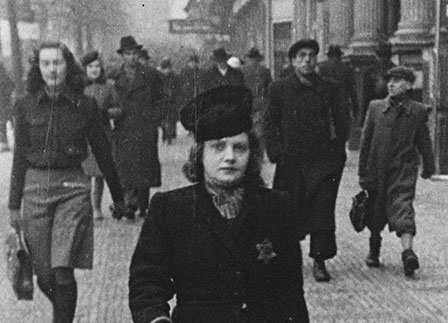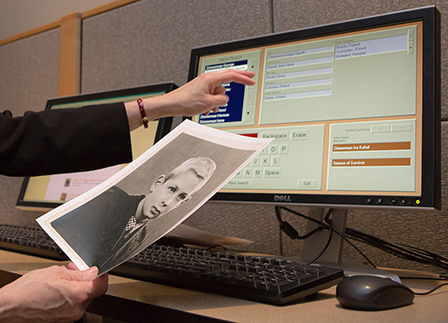- Brief Narrative
- Photographic print created in 1935 by Mark Markov-Grinberg, depicting an official, idealized version of Soviet women farm workers. Markov-Grinberg was a Soviet Jewish photographer, World War II correspondent, and major Social Realist photographer during the Stalinist era of the 1930s-1940s. He worked for major newspapers and journals, including TASS. Markov-Grinberg was a war correspondent during the Soviet-Finnish War from 1939-1940 and, in 1941, was drafted to fight in World War II. While a soldier, he continued his work as a photographer and army correspondent. After the war, he returned to his job at TASS.
- Artwork Title
- Happy Maternity, Stavropol Territory, 1935
- Date
-
depiction:
1935
- Geography
-
creation:
Stavropolskii krai, Russia
- Credit Line
- United States Holocaust Memorial Museum Collection, Gift of Patricia L. Cohen and Eddie Sutton
- Signature
- back, top, Russian script, pencil : M. Markov-Grinberg
- Contributor
-
Artist:
Mark Markov-Grinberg
Subject:
Mark Markov-Grinberg
- Biography
-
Mark Borisovich Markov-Grinberg was born on November 27, 1907, in Rostov-on-Don, Russia. He learned photography at secondary school. In 1925, he took his first job as a photographer for the Sovetsky Yug (Soviet South) newspaper and worked as a freelance correspondent for Ogonyok magazine. In 1926, Markov-Grinberg moved to Moscow and worked for various trade union newspapers and the magazine, Krasnoarmeyskaya Smena (Transformation). In 1930, he accepted an offer to work for the Fotokhronika TASS (Telegraph Agency of the Soviet Union). He traveled around the country photographing the official Soviet Union: major construction projects, collective farms, and happy workers engaged in building Soviet Society, as well as prominent Russian and foreign personalities. His photographs appeared in major Soviet publications, including USSR in Construction, a magazine that documented Stalin’s Five-Year Plans to industrialize the Soviet Union. In 1934, TASS commissioned Markov-Grinberg to create a photo essay detailing a day in the life of Ukrainian miner, Nikita Izotov. He created an iconic portrait of Izotov as a Socialist worker hero. The Izotov photo essay launched Markov-Grinberg's career as a Stalin-era photographer and he became one of the most important photographers of his generation. His work was part of the socialist realist movement in photography which pictured life as it should be in idealized images made to look like objective recordings of things as they were.
During the Soviet-Finnish War (1939-1940), Markov-Grinberg worked for TASS as a war correspondent and documented the fighting on the Karelian Isthmus. In September 1941, he was drafted into the Red Army, and continued to take photographs. He became the army correspondent for the military publication, Slovo Boitsa (Soldier’s World), in July 1943. He created well-known images of the Battle of Kursk and the crematorium at Stutthof concentration camp, when it was liberated on May 9, 1945, by the Soviet Army.
Markov-Grinberg lost his job with TASS in 1948 as a result of the anti-Semitic climate of late Stalinism. After his demobilization in 1953, he worked as a photographer for the Red Army Illustrated Gazette and, later, for the photography publishing office of the Soviet Union Agricultural Exhibition, a theme park about the People’s Economy. From 1957–1973, Markov-Grinberg worked for the Club and Art Hobby magazine. He took part in photography exhibitions in the USSR and abroad. An honorary member of the Russian Union of Art Photographers, Markov-Grinberg died in 2006 at the age of 99.



